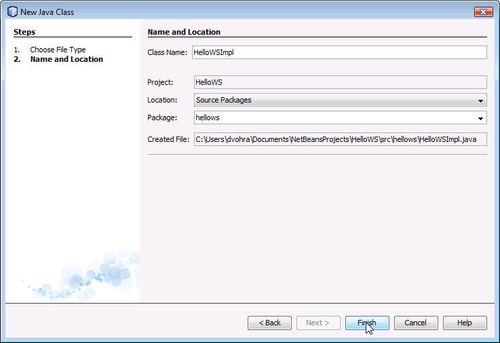Next, create the implementation class. Select File | New File. In New File, select Java in Categories and Java Class in File Types, and click on Next:

Specify the Class Name (HelloWSImpl), Package (hellows), and click on Finish:

The web service implementation class HelloWSImpl is annotated with the @WebService annotation and implements the HelloWS interface. The implementation class contains a method hello that takes a String parameter for name and returns a Hello message containing the name. The implementation class is listed as follows:
package hellows;
import javax.jws.*;
@WebService(portName = "HelloWSPort", serviceName = "HelloWSService", targetNamespace = "http://hellows/", endpointInterface = "hellows.HelloWS")
public class HelloWSImpl implements HelloWS {
public String hello(String name) {
// replace with your impl here
return "Hello "+name +" Welcome to Web Services!";
}
}
Similarly, add a Java interface for a SEI. The SEI declares public methods that clients may invoke on the service. The SEI is optional, as a web service implementation class implicitly defines a SEI. As we specified, an explicit SEI with an endpointInterface element in the @WebService annotation in the implementation class, we must include a SEI with public methods made available on the service. The service endpoint interface HelloWS contains the hello method annotated with the @WebMethod annotation:
package hellows;
import javax.jws.WebMethod;
import javax.jws.WebService;
@WebService(name = "HelloWS", targetNamespace = "http://hellows/") public interface HelloWS {
@WebMethod(operationName = "hello")
public String hello(String name);
}
The implementation class and the endpoint interface are shown in the following NetBeans project:

